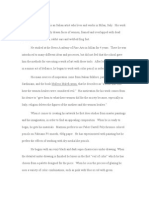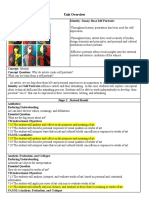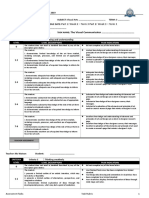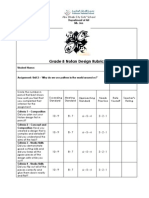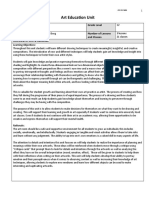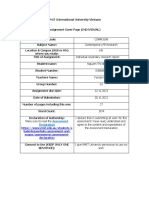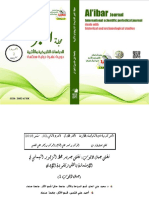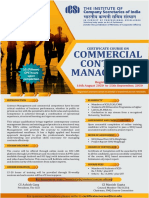Aesthetic Collage Lesson Plan
Aesthetic Collage Lesson Plan
Uploaded by
api-399209238Copyright:
Available Formats
Aesthetic Collage Lesson Plan
Aesthetic Collage Lesson Plan
Uploaded by
api-399209238Original Title
Copyright
Available Formats
Share this document
Did you find this document useful?
Is this content inappropriate?
Copyright:
Available Formats
Aesthetic Collage Lesson Plan
Aesthetic Collage Lesson Plan
Uploaded by
api-399209238Copyright:
Available Formats
Spring 2018 ARTE Lesson Plan Format 1.19.
18
-----EACH LESSON IN LEARNING SEGMENT CANNOT BE LONGER THAN 4 PAGES-----
Title of Learning Segment: Aesthetic Fashion Collage Grade: Art I or Art II
Prior Knowledge include relevant content knowledge, media use, and skill development):
Collage: Aesthetic Inventory; Pattern; Drawing; Color Theory
Central Focus: Students will create a collage inventory to guide a garment design.
Learning Segment Overview Four lessons (45 minute)
e.g. Lesson 1 (Day 1) Intro/ Motivation/Engage/Research:
Create collection of magazine scraps
Show examples of collaged design
Demo creating a garment collage from a fashion template
Lesson 2 (Days 2-3) Instruction process/Procedure/Explore/Guided Practice
Collect reference images of high fashion
Practice working with fashion template in artist journal/sketchbook
Mix-pair-share final ideas
Work on final product
Lesson 3 (Day 4) Present/ Respond and/or connect/present
Finalize final project
Demo mounting strategies
Lesson 4 (Day 5) Summative Assessment/ Evaluation/Closure
Answer reflection question in sketchbook/artist journal
Standard, Objective, & Assessment use similar language
Standard Learning Objective Assessment
Lesson 1 NVAS: VA.CR.1.2.LA
VA.CR.1 I can shape an artistic investigation Diagnostic: Students will have
Generate and of an aspect of present-day life previously created an aesthetic
conceptualize using a contemporary practice of art inventory
artistic ideas and or design
work Formative: Mix-Pair-Share
Lesson 1 SCVAS: I can create a body of work in a sketches with classmates
VA.CR.AH.1 specific medium that explores a
I can use the personal theme, idea, or concept. Summative: Journal entry
elements and reflection on garment design (“How
principles to does this reflect your current
create a work of fashion aesthetic, or how does it
art not?”
Lesson 2 NVAS: VA.Re.7.2.11a
VA.R.7 I can recognize and describe
Perceive and personal aesthetic and empathetic
analyze artistic responses to the natural work and
work constructed environments.
Lesson 2 SCVAS: VA.CR.MA.2
VA.CR.2 I can invent different ways to
I can use different combine materials to develop a
materials, personal style
techniques, and
processes to
make art
Spring 2018 ARTE Lesson Plan Format 1.19.18
-----EACH LESSON IN LEARNING SEGMENT CANNOT BE LONGER THAN 4 PAGES-----
Lesson 3 NVAS: VA.Re.7.2.11a
VR.Re.7 I can evaluate the effectiveness of
I can perceive an image or images to influence
and analyze ideas, feelings, and behaviors of
artistic work specific audiences
Lesson 3 SCVAS: VA.R.AH.5.1
VA.R.5 I can justify the purpose or intent of
I can interpret and my collage
evaluate the
meaning of an
artwork
Academic Language
1. Language Function—Students will analyze their aesthetic through a reflective journal entry.
2. Vocabulary–Aesthetic: the branch of philosophy that deals with the nature and value of art
objects and experiences. It is concerned with identifying the clues within works that can be used
to understand, judge, and defend judgments about those works.
3. Discourse OR Syntax: Reflected- Discourse
4. Practice: “How does this reflect your current fashion aesthetic, or how does it not?”
Key Materials: slightly translucent paper, magazines, scissors, pencils, colored pencils (or tool
of choice), sketchbooks, technology (for reference imagery- phones, ipads, etc.),
Instructional Strategies and Learning Tasks (Procedures & Timelines)
Day One:
As students enter class, there are stacks of magazines and scissors at each table
Instructions will be displayed on board and teacher will recite them once everyone is
seated: “using the magazines at your table, find at least 10 images/colors/patterns
that appeal to you and cut or tear them out
Give students half an hour/25 minutes to collect their images
o Walk around and encourage students to trade/share as needed; encourage a
wide variety of clippings
Pull up presentation of lesson, introduce lesson, then show an example of collaged
design
Demonstrate how to use fashion template to create garment and demonstrate how to
collage garment using the template
End class with questions about the assignment, allow students to add to their
inventory or trade between next class if needed/wanted.
Day Two/Three:
As students enter class, a bellringer will be posted on the board and students will be
allowed to use technology to find reference images
Following the bellringer, students will be called by tables to choose a design template
and begin practicing template design in their sketchbooks or artist journals
Students will mix-pair-share their ideas
Students will work on their final fashion design
Day Four:
As students enter the class, their final collages will be at their spots, along with
supplies to finish up their collages. Students will be given 5-10 minutes to finalize
work before mounting
As students finalize their work, teacher will pass out pre-cute mounting paper and
rubber cement to tables
Spring 2018 ARTE Lesson Plan Format 1.19.18
-----EACH LESSON IN LEARNING SEGMENT CANNOT BE LONGER THAN 4 PAGES-----
Students will then be shown a quick mounting demonstration using rubber cement
and registration
Students will spend the rest of class mounting their work and answering reflection
questions in their sketchbooks
Accommodations Universal Design for Learning used in this art lesson.
Representation: accessibility scissors (left or right handed), speaking expectations and
displaying them on the board (audio and visual)
Engagement: allowing students to work individually and in groups
Expression: allowing students to choose their own template and mounting paper color
Individual student with special needs: follow IEP or Accommodations as needed
Resources Johanna Goodman- artist inspiration
Artifacts model template, powerpoint + bellringer
Reflection I think the actual collage making might take more than 2 class periods, depending
on the class duration and how involved the students get with it.
You might also like
- Top Network Engineer Interview Questions and Answers PDF100% (1)Top Network Engineer Interview Questions and Answers PDF8 pages
- Lesson Plan of Writing Integrating GrammarNo ratings yetLesson Plan of Writing Integrating Grammar3 pages
- Project P3-3 Foreground, Middle Ground, and BackgroundNo ratings yetProject P3-3 Foreground, Middle Ground, and Background9 pages
- Garrett Bouslough - Essay On Marco MazzoniNo ratings yetGarrett Bouslough - Essay On Marco Mazzoni5 pages
- 2019 Assessment Task Year 9 Unit 3 RubricNo ratings yet2019 Assessment Task Year 9 Unit 3 Rubric3 pages
- Quarter 4 Self Asseessment For Notan Design 2013No ratings yetQuarter 4 Self Asseessment For Notan Design 20132 pages
- Ks4 Igcse Art and Design Schemes of WorkNo ratings yetKs4 Igcse Art and Design Schemes of Work10 pages
- Gcse Landscape Project 12 Week Plan UpdatedNo ratings yetGcse Landscape Project 12 Week Plan Updated9 pages
- Semester Overview Arts Visual Arts Year 1 2012-2013No ratings yetSemester Overview Arts Visual Arts Year 1 2012-20132 pages
- 5 Steps To Creating Authentic AssessmentNo ratings yet5 Steps To Creating Authentic Assessment1 page
- 12 5 The Still Life Value and Scratchboards100% (2)12 5 The Still Life Value and Scratchboards9 pages
- Painting With Color Lesson-Images RemovedNo ratings yetPainting With Color Lesson-Images Removed9 pages
- Adaptive Clustering For Mobile Wireless Networks - IEEE Journal On Selected Areas in Communications PDFNo ratings yetAdaptive Clustering For Mobile Wireless Networks - IEEE Journal On Selected Areas in Communications PDF4 pages
- REPORT COMM2698 ASN01 NguyenThiNhuQuynh S3880896 03No ratings yetREPORT COMM2698 ASN01 NguyenThiNhuQuynh S3880896 0327 pages
- Memorandum Circular No. 05-08-2005 Subject: Voice Over Internet Protocol (Voip)No ratings yetMemorandum Circular No. 05-08-2005 Subject: Voice Over Internet Protocol (Voip)4 pages
- Government Elementary School Profile (GESP) : Online Orientation On BEIS Forms School Year 2020-2021No ratings yetGovernment Elementary School Profile (GESP) : Online Orientation On BEIS Forms School Year 2020-202173 pages
- CON101 Assignment 3: Network Security: Satyam Kumar Modi December 2020No ratings yetCON101 Assignment 3: Network Security: Satyam Kumar Modi December 20202 pages
- Bài tập tiếng Anh lớp 10 unit 4 kèm đáp án chuẩn PDFNo ratings yetBài tập tiếng Anh lớp 10 unit 4 kèm đáp án chuẩn PDF10 pages
- The Journal of Academic Librarianship: Amy CatalanoNo ratings yetThe Journal of Academic Librarianship: Amy Catalano7 pages
- Presented By-T.Krushi Kumar Sec-C ROLL NO-109 Icbm-SbeNo ratings yetPresented By-T.Krushi Kumar Sec-C ROLL NO-109 Icbm-Sbe21 pages
- CS Core Performance Dashboard - MAP02MSS - 19!04!2022No ratings yetCS Core Performance Dashboard - MAP02MSS - 19!04!2022541 pages
- Alhajj. M. Inscription of Jabal Thabooob A New Yemeni Zaburian Inscription in Resorting of Allah and Strengthen Faith PDFNo ratings yetAlhajj. M. Inscription of Jabal Thabooob A New Yemeni Zaburian Inscription in Resorting of Allah and Strengthen Faith PDF33 pages
- Commercial Contract Management: Certificate Course OnNo ratings yetCommercial Contract Management: Certificate Course On1 page
- Submitted by Lourdan Elaba Xi-Stem Einstein Submitted To Mrs. BongonNo ratings yetSubmitted by Lourdan Elaba Xi-Stem Einstein Submitted To Mrs. Bongon7 pages













